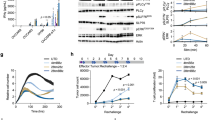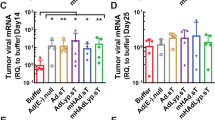Abstract
We have previously shown that the local-membrane bound 4-1BB ligand and IL-12 gene transfer induced a significant antitumor response in a mouse colon carcinoma model. However, a high viral dose was required in order to achieve the best efficacy. In this study, we hypothesize that the systemic administration of soluble Ig-4-1BB ligand can give rise to better T-cell immune activation than local gene delivery. With potential clinical applications in mind, we further compare whether the natural 4-1BB ligand fused to mouse IgG2a (Ig-4-1BBL) would be as effective as the agonistic anti-4-1BB antibody. The dimeric form of Ig-4-1BBL was purified from HeLa cells transduced with a recombinant adenovirus (ADV/Ig-4-1BBL) expressing Ig-4-1BBL. Functional activity was confirmed by the ligand's ability to bind to activated splenic T cells or bone marrow (BM)-derived dendritic cells (DCs) that express 4-1BB receptor. The soluble Ig-4-1BBL efficiently costimulated CD3-activated T-cell proliferation in vitro. More importantly, it induced tumor-specific CTLs as effectively as the agonistic anti-4-1BB antibody. When combined with IL-12 gene transfer, systemic administration of the Ig-4-1BBL proved to be more potent than local gene delivery. In addition, the Ig-4-1BBL is as potent as the agonistic anti-4-1BB antibody for the treatment of hepatic MCA26 colon carcinoma, resulting in 50% complete tumor regression and long-term survival. In long-term surviving mice, both treatment modalities induced persistent tumor-specific CTL activity. In summary, these results suggest that the systemic delivery of Ig-4-1BBL can generate a better antitumor response than local gene delivery. Ig-4-1BBL had equivalent biological functions when compared to the agonistic anti-4-1BB antibody. Thus, soluble 4-1BBL dimmer can be developed as a promising agent for cancer therapy in humans.
This is a preview of subscription content, access via your institution
Access options
Subscribe to this journal
Receive 12 print issues and online access
$259.00 per year
only $21.58 per issue
Buy this article
- Purchase on Springer Link
- Instant access to full article PDF
Prices may be subject to local taxes which are calculated during checkout









Similar content being viewed by others
References
Vinay DS, Kwon BS . Role of 4-1BB in immune responses. Semin Immunol 1998; 10: 481–489.
Kwon B et al. 4-1BB: still in the midst of darkness. Mol Cells 2000; 10: 119–126.
Pollok KE et al. Inducible T cell antigen 4-1BB. Analysis of expression and function. J Immunol 1993; 150: 771–781.
Melero I et al. NK1.1 cells express 4-1BB (CDw137) costimulatory molecule and are required for tumor immunity elicited by anti-4-1BB monoclonal antibodies. Cell Immunol 1998; 190: 167–172.
Futagawa T et al. Expression and function of 4-1BB and 4-1BB ligand on murine dendritic cells. Int Immunol 2002; 14: 275–286.
Wilcox RA et al. Cutting edge: expression of functional CD137 receptor by dendritic cells. J Immunol 2002; 168: 4262–4267.
Pan PY et al. Regulation of dendritic cell function by NK cells: mechanisms underlying the synergism in the combination therapy of IL-12 and 4-1BB activation. J Immunol 2004; 172: 4779–4789.
Cannons JL et al. 4-1BB ligand induces cell division, sustains survival, and enhances effector function of CD4 and CD8 T cells with similar efficacy. J Immunol 2001; 167: 1313–1324.
Kim YJ, Broxmeyer HE . Therapeutic potential of 4-1BB (CD137) as a regulator for effector CD8 (+) T cells. J Hematother Stem Cell Res 2001; 10: 441–449.
Melero I et al. Monoclonal antibodies against the 4-1BB T-cell activation molecule eradicate established tumors. Nat Med 1997; 3: 682–685.
Kim JA et al. Divergent effects of 4-1BB antibodies on antitumor immunity and on tumor-reactive T-cell generation. Cancer Res 2001; 61: 2031–2037.
Martinet O et al. T cell activation with systemic agonistic antibody versus local 4-1BB ligand gene delivery combined with interleukin-12 eradicate liver metastases of breast cancer. Gene Therapy 2002; 9: 786–792.
Martinet O et al. Immunomodulatory gene therapy with interleukin 12 and 4-1BB ligand: long-term remission of liver metastases in a mouse model. J Natl Cancer Inst 2000; 92: 931–936.
Chen SH et al. Rejection of disseminated metastases of colon carcinoma by synergism of IL-12 gene therapy and 4-1BB costimulation. Mol Ther 2000; 2: 39–46.
Wilcox RA et al. Provision of antigen and CD137 signaling breaks immunological ignorance, promoting regression of poorly immunogenic tumors. J Clin Invest 2002; 109: 651–659.
Pullen SS et al. High-affinity interactions of tumor necrosis factor receptor-associated factors (TRAFs) and CD40 require TRAF trimerization and CD40 multimerization. Biochemistry 1999; 38: 10168–10177.
Ye H, Wu H . Thermodynamic characterization of the interaction between TRAF2 and tumor necrosis factor receptor peptides by isothermal titration calorimetry. Proc Natl Acad Sci USA 2000; 97: 8961–8966.
Morris AE et al. Incorporation of an isoleucine zipper motif enhances the biological activity of soluble CD40L (CD154). J Biol Chem 1999; 274: 418–423.
Caruso M et al. Adenovirus-mediated interleukin-12 gene therapy for metastatic colon carcinoma. Proc Natl Acad Sci USA 1996; 93: 11302–11306.
Holmes K, Fowlkes BJ . Preparation of cells and reagents for flow cytometry. In: Coligam JE, Kruisbeek AM, Margulies DH, Shevach EM, Strober W (eds). Current Protocols in Immunology. John Wiley & Sons, Inc.: USA, 1991, pp 5.3.1–5.3.23.
Acknowledgements
We thank Dr Lieping Chen for providing anti-4-1BB monoclonal antibodies, Drs Lieping Chen and Drew Pardoll for helpful discussion. This study is supported in part by NCI RO1 grants CA 70337 and CA 84404, Sharp Foundation grant to SHC, and Goehner Foundation, Switzerland to BVS.
Author information
Authors and Affiliations
Rights and permissions
About this article
Cite this article
Xu, DP., Sauter, B., Huang, TG. et al. The systemic administration of Ig-4-1BB ligand in combination with IL-12 gene transfer eradicates hepatic colon carcinoma. Gene Ther 12, 1526–1533 (2005). https://doi.org/10.1038/sj.gt.3302556
Received:
Accepted:
Published:
Issue Date:
DOI: https://doi.org/10.1038/sj.gt.3302556
Keywords
This article is cited by
-
CD137 stimulation and p38 MAPK inhibition improve reactivity in an in vitro model of glioblastoma immunotherapy
Cancer Immunology, Immunotherapy (2013)
-
Immunmodulierende Antikörper in der Dermatoonkologie
Der Hautarzt (2008)
-
Rejection of Metastatic 4T1 Breast Cancer by Attenuation of Treg Cells in Combination With Immune Stimulation
Molecular Therapy (2007)
-
Dual immunoregulatory pathways of 4-1BB signaling
Journal of Molecular Medicine (2006)



